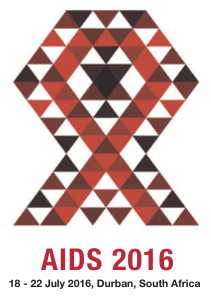21st International AIDS Conference (AIDS 2016), 18-22 July 2016, Durban, South Africa
1 August 2016. Related: Conference reports, Conference index, World AIDS 21 Durban 2016.

The 21st International AIDS Conference (AIDS 2016) was held from 18-22 July 2016 in the coastal town of Durban in South Africa.
Attended by more than 18,000 delegates, this vital meeting covers all aspects of HIV research: from early basic science studies looking at mechanisms for a cure to real world practice for ensuring human rights are respected for the 35 million people living with HIV globally.
Historically, this meeting is significant for returning to Durban, sixteen years after the World AIDS Conference was first held in an African country.
Over this time, remarkable advances have been made in global healthcare but a continued theme for the conference was that this work is still only half completed. Although more than 17 million people now access HIV treatment (ART) globally, universal access is increasingly raised as the most appropriate target if the HIV epidemic is to ever be reduced.
Several other important workshops were held before the main conference, including meetings focused on paediatrics, TB confection and HIV cure.
The AIDS 2016 programme is online as a searchable database.
http://programme.aids2016.org/Abstract/Index
Although the search is good at finding abstracts and when availble links to posters are included on this page, further links to webcasts, and slidesets are only accessible through the online conference programme.
This requires searching for and then viewing the conference session in the programme where the study is presented (whether as an oral abstract, plenary talk or other type of presentation). Once the session window is opened, a column to the right of the presentation title shows links to the abstract, plus slides and webcasts if available. Webcasts can either be viewed in the session window or as separate links on YouTube.
https://www.youtube.com/user/iasaidsconference/videos
A disappointingly large number of presentations are neither available as webcasts nor supported by slides. This is not acceptable for the few hundred presentations selected as highlight from many thousands acccepted as posters.
The IAS conference should have sufficient confidence to make oral presentations conditional on consent to the presentation being available online. This is common practice for the annual CROI meetings which have a stronger scientific prestige.
Not highlighing in the progrmme when sessions will (or will not) be webcast is also unhelpful.
The following reports are included in this issue of HTB.
- ZERO: no linked HIV transmissions in PARTNER study after couples had sex 58,000 times without condoms
- PrEP studies at AIDS 2016: includes first preclinical data with EFdA
- Dual therapy with dolutegravir + 3TC keep viral load undetectable: 48 week results from PADDLE study
- Once-daily raltegravir at last available: 48 week results from ONCEMRK study
- Dual long-acting cabotegravir plus rilpivirine injections: 48-week results from LATTE-2
- Dolutegravir is superior to boosted atazanavir in women in the ARIA study
- PROMISE results support WHO recommendations for pregnant and breastfeeding women: more needs to be done to improve ART acceptability and adherence
- Sub-Saharan African countries moving quickly to recommend “Treat All”
- Efavirenz associated with suicide risk in analysis from START study
- CD4:CD8 ratio is more sensitive marker of risk than CD4 counts in analysis from START study
- Treatment in primary HIV infection is significantly more likely to normalise CD4:CD8 ratio
- Publications launched at AIDS 2016

